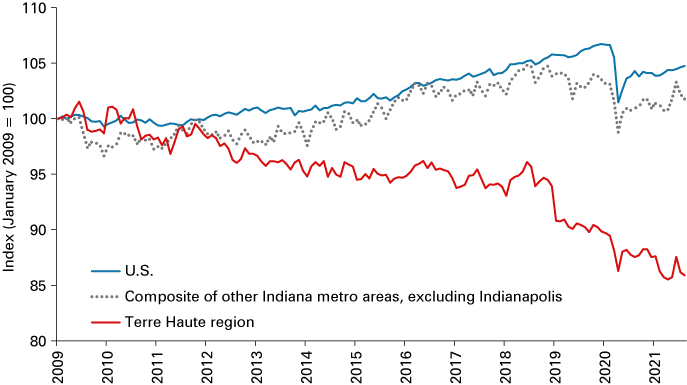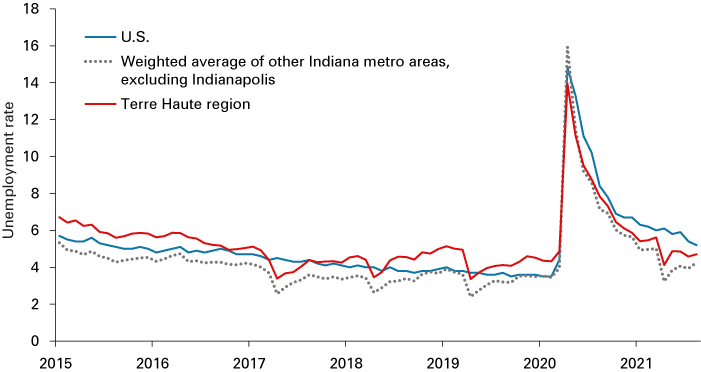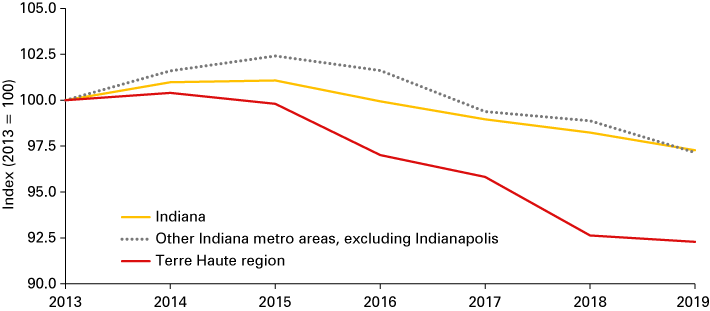Terre Haute forecast 2022

Professor of Economics, Indiana State University

Associate Professor of Economics, Rose-Hulman Institute of Technology
Like most municipalities in this early post-pandemic era, “now hiring” signs dot the Terre Haute landscape. They, along with occasional announcements of new investments, new jobs and a few notable larger projects, are like the bright fall colors that dazzle. The reality, however, is that they merely distract from the unpleasant contours in the terrain beneath. Pushing aside the distractions, the defining feature of the Terre Haute economic landscape continues to be its shrinking labor force. Unlike the nation and state, Terre Haute’s labor force has been in secular decline. From a mid-1990s peak of nearly 90,000, it has declined over a quarter-century to the point that it has, on occasion, dipped below 70,000.
Figure 1 displays the labor force relative to its position near the trough of the 2008–2009 recession for the nation, other Indiana metropolitan areas and the Terre Haute MSA. While the national and state data display the much-commented-upon “reverse square root” pattern (where workers lost during the shutdowns have been slow to return after the late 2020 rebound), the loss of workers in Terre Haute actually accelerated during a period of robust national employment before the pandemic, experienced a relatively modest decline during the pandemic, and since then has continued its downward march. This is despite a robust local construction environment.
Figure 1: Labor force

Note: Data are shown through August 2021.
Source: U.S. Bureau of Labor Statistics
In times of recovery it can be easy to overlook this trend if one only pays attention to unemployment rates, announcements from local boosters and civic leaders, or news items about local businesses. In terms of unemployment, the Terre Haute region actually has fared relatively well coming out of the pandemic (see Figure 2). But, of course, a low unemployment rate when the labor force is shrinking is a “glass is half full” take on the situation.
Figure 2: Seasonally adjusted unemployment rates

Note: Data are shown through August 2021.
Source: U.S. Bureau of Labor Statistics and authors’ calculations
To get another “glass is half full” perspective, focus on the nearly completed convention center downtown or the long-promised, but not-yet-realized, casino project. The convention center, as well as Indiana State University’s renovation of its Hulman Center, have been significant capital improvements for the downtown area. It is still a bit early, however, to reach any conclusions about the economic impact of those projects. Slated to be complete by March 1, 2022, the first booked event for the convention center will be a meeting of 150 state firefighters in 2023. This is a relatively small event for a center of that size. Prior readers of our work on Terre Haute will recall that we disagree on the center’s potential (one of us believes it is likely to become a glorified wedding venue, the other thinks it could be transformational). At this point, there is still too little data to tell.
With regard to the casino project, approval was given in late 2021 to an operator who plans to build it at the main Terre Haute interstate exit at U.S. 41 and I-70. From an economic impact point of view, this is a marginally better choice than other operators had proposed. Still, it will be relatively easy for patrons to drive to Terre Haute, spend their money in the casino, and then leave without ever spending a dime elsewhere in the area. While the casino, if completed, will certainly create a good number of new jobs, most will be relatively low-paying. Furthermore, as we pointed out in a previous year’s forecast, its location seems engineered to limit the magnitude of positive economic spin-off effects.1
In the manufacturing area, recent news items—such as Great Dane’s expansion with 125 new jobs, Steel Dynamics’ announcement of a $231 million upgrade that promises to bring with it 84 new jobs, or Fitesa’s acquisition of Tredegar and an associated expansion with 34 additional jobs—always generate hope for the future. Such announcements, however, must be placed in context: The region has shed nearly 20,000 workers and about the same number of jobs since the mid-1990s. The largest private employer of the 1980s, Columbia House, no longer exists. The largest private employer of the 1990s and 2000s, Sony DADC, is a shell of its former self.
Other sectors also have experienced setbacks that have kept the local economy from taking off. Enrollment at the county’s third-largest employer, Indiana State University, is approximately 35% lower in 2021 than it was in 2018. The city was disappointed not to have its airport selected as the foreign military training site for the F-35. Finally, in what could also be a blow to the city regarding government funding for the next decade, the 2020 census showed a significant population decline, in part due to the curious way that the census accounted for college students.
With regard to ISU’s enrollment, even if the university manages to rebound in the aggregate, it is quite unlikely that the composition of those students will help the community. This has little to do with anything happening (or failing to happen) at ISU and everything to do with regional demographics and higher education realities. Homes to regional campuses in the Midwest (including others in Indiana, such as Muncie, Evansville, New Albany and Richmond) will all see dramatic declines in face-to-face freshmen. First, there simply were not enough children born after 2008 to produce healthy enrollments at these institutions (a situation referred to in academic circles as a “looming enrollment cliff”). Second, any growth they experience will almost exclusively be in online students. Those students pay tuition that drives university employment, but their living expenses (on the same order as tuition) get spent where they happen to live … which in this case won’t be Terre Haute.
Regarding Vigo County’s largest employer, its school corporation, the local high schools are all desperately in need of near-term attention. The choices presented to the community in late 2021 by the school corporation are largely predicated on a politically astute but demographically dubious assertion that the area still needs three high schools. Births in the Terre Haute MSA have dropped by about 8% since 2013; in comparison, other areas in the state have experienced, on average, a drop of about 3% (see Figure 3).
Figure 3: Births

Source: Indiana Department of Health
In addition to this, out-migration of families continues at an alarming pace. There are 3% fewer kindergarteners than would be predicted by their cohorts’ births, and each year the size of grades 1 through 8 classes are 1.75% smaller than would be predicted by the size of the prior grade’s class. Communities around the state that are experiencing growth are building schools (sometimes building multiple elementary schools on the same lot). In contrast, Terre Haute is abandoning schools, even ones with relatively recent renovations.
Regardless of which option is chosen, and assuming that a bond issue to finance this massive undertaking actually passes, the largest tax increase in Vigo County history is right around the corner. On top of this, prospects for passage of such a bond issue may have been made more difficult by the county’s 2018 decision to increase taxes to fund a large new jail. Nevertheless, the choice seems existential for the area: Employers not only need a viable labor force, they want schools that will attract family-focused workers.
In our view, the long-term fortunes of the city and region are not likely to be determined by the location of a casino or the success (or failure) of the convention center. They are likely to be determined by civic leaders and prominent employers reversing the long-term decline and short-term cratering evidenced in Figure 1.
In last year’s outlook, we put it this way:
“The principal challenge facing the community is how to provide the social infrastructure needed to make Terre Haute an appealing place to live and raise a family in early 21st century America.”2
Terre Haute has parts of that infrastructure: good parks, cultural activities such as the Swope Art Museum and the Terre Haute Symphony, entertainment offerings at local universities, and good health care facilities. We don’t profess to know what the magic elixir is that could capitalize on these strengths and change current trends, but we suspect that it is not a large jail or casino. Drivers of rejuvenation are likely to be the viability of the manufacturing and health care sectors, an enrollment recovery at ISU, and a wise choice regarding the necessary renovations for the county’s three high schools.
In our 2010 outlook—commenting on what was then early signs of a decline in the labor force—we observed that “such labor market weakness, if chronic, will contribute to population exit and brain drain that will weaken longer-term prospects for the area economy.”3 One need look no further than birth rates (shown in Figure 3) and falling class sizes in the school system to find evidence of chronic decline. Thus, we feel the area’s shrinking population and labor force should be the be-all and end-all for local leaders: Until this trend is reversed, the local economy will continue to disappoint, regardless of the occasional flash of bright color.
Notes
- Robert Guell and Kevin Christ, “Terre Haute forecast 2020,” Indiana Business Review, Winter 2019, www.ibrc.indiana.edu/ibr/2019/outlook/terrehaute.html
- Robert Guell and Kevin Christ, “Terre Haute forecast 2021,” Indiana Business Review, Winter 2020, www.ibrc.indiana.edu/ibr/2020/outlook/terrehaute.html
- Kevin Christ and Robert Guell, “Terre Haute forecast 2010,” Indiana Business Review, Winter 2009, www.ibrc.indiana.edu/ibr/2009/outlook/terrehaute.html



